Welcome to Old School Month on Eternal Central. We’re looking at a different Old School 93-94 deck each day of the month. Today’s deck is UGW Titania’s Prison, named for playing the Blue-Green-White color combination, with Titania’s Song as a kill condition in a prison deck.
I have played many variants with Titania’s Song in Old School over the past few years, including Mono Green, Green-White, Green-White-Black, Blue-Green-White, four colors, and so on. I have found that 2-3 colors is the most consistent for mana production, and believe that the synergies available to Blue-Green-White are the best positioned in most balanced 93-94 metagames. Here is an example of a version I used to take down a small tournament with last year.
Ran #ECOldSchool2016, but got to play some #OldSchoolMTG at impromptu #BarleysOpen2016 round robin 8-man. 1st place 5-2 with Titania's Song. pic.twitter.com/c4ExKQBPMb
— Jaco (@JMJACO) October 31, 2016
Constructing Titania’s Prison
Titania’s Song is a build-around card, meaning you want to focus your deck on playing to its strengths and unique ability. It allows you to turn non-creature artifacts in to artifacts, which can be used as a great kill condition if you are playing tons of artifacts. You can control the battlefield, and then kill your opponent in the blink of an eye.
Fortunately, many of the best cards in the Old School 93-94 card pool are artifacts, which means that Titania’s Song has a natural home in the format, if you can find the best combination of artifacts to use with it. Here is the last version of Blue-Green-White prison that I recently played.
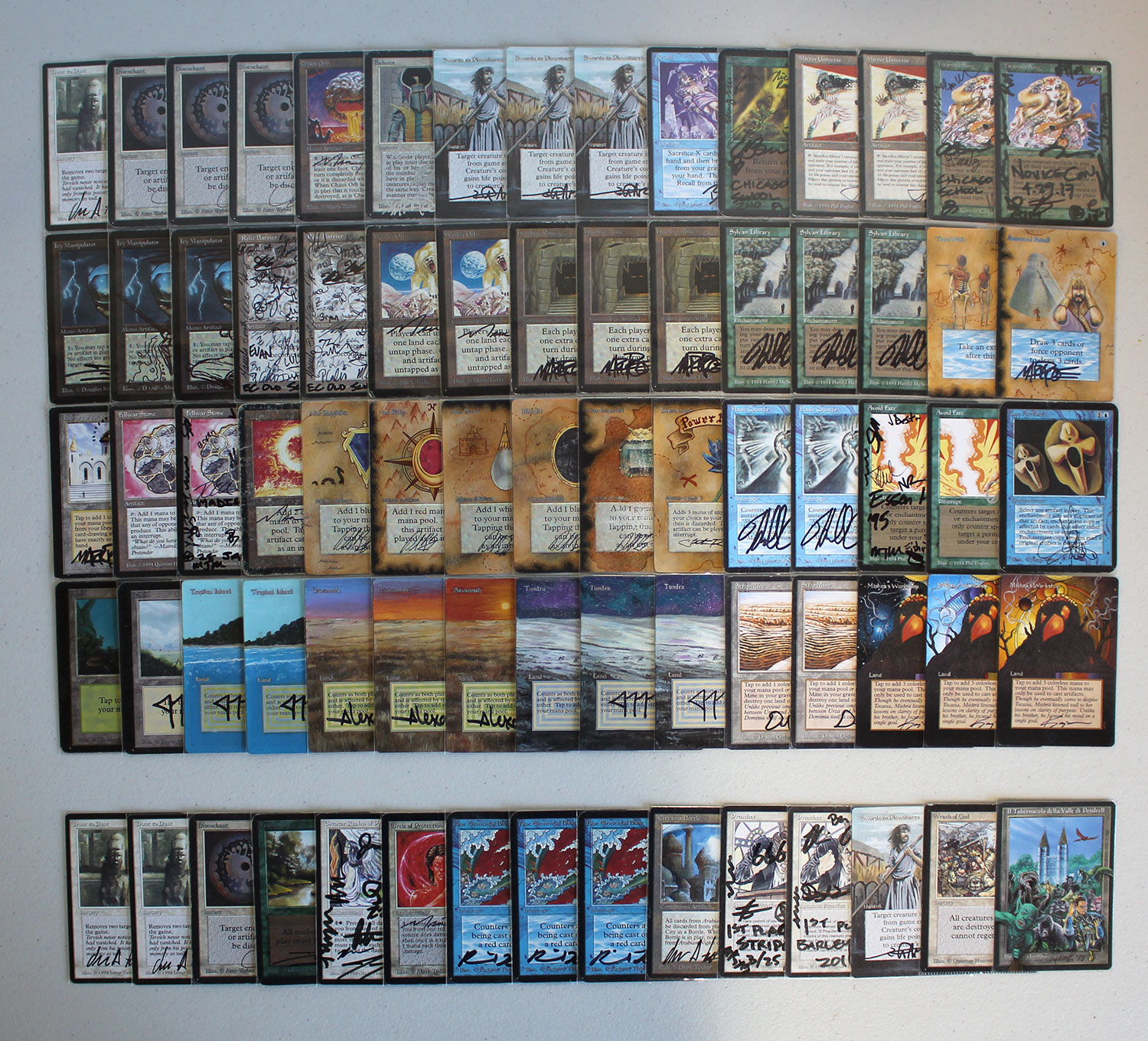
Creature Choices
Like some of the other decks we’re featuring this month, this deck primarily operates as a creatureless deck, in order to create dead draws for the opponent, who may be stuck with useless copies of Swords to Plowshares in hand all game, for example. This creates minor virtual card advantage over the course of a game, which often compounds over time (because the useless resource cannot be used for any advantage on a single turn, or recurring turns).
Draw Engines
Playing blue allows for the natural choice of Ancestral Recall and Time Walk (which is the best card in the deck, as we’ll discuss later), and also allows for Recall to be played as a recursion mechanism. Because we are playing many other activated abilities and constantly want to be using mana on other things, I have chosen to forego Jayemdae Tome and Braingeyser in this version, but they are worthy considerations. Timetwister is a boom or bust type card, and we are trying to accumulate many small advantages over time with this deck, both mana and resource-wise that Timetwister could undo, so that is absent as well.
Howling Mine is a seemingly innocuous card, but when combined with Relic Barrier or Icy Manipulator, it becomes a one-side draw engine that can quickly get out of hand. Without or without Howling Mine, Sylvan Library is also another potent tactic that you can use to sort through your deck, and use to dig to find what you need faster. It is probably the second best card in this deck.
Control Elements
Decks that play Icy Manipulator and/or Relic Barrier often go hand in hand with those that play Howling Mine and Winter Orb. Howling Mine and Winter Orb were originally printed as “Continuous Artifacts,” meaning they would work continuously as long as they were untapped. Fortunately, the Orcale wording of each has been updated over the years to reflect this original intent. Both Icy Manipulator and Relic Barrier can be used to tap your own Winter Orb or Howling Mine, in order that they would shut off temporarily to gain a one-sided advantage, so they are each logical inclusions when playing this package of artifacts. They also happen to allow non-blue decks to play a strong control role in 93-94, by virtue of taxing and controlling elements of the battlefield.
To most people, removal is also considered a form of control, whether that be controlling creatures or other permanents in play. Some mix of Disenchant, Divine Offering, and Dust to Dust are essential countertactics to handle pesky artifacts and enchantments that can clog up the board, or interfere with your game plan. Balance, Swords to Plowshares, and Wrath of God are all great main deck cards against creatures, as is The Abyss if you are going with a black splash.
Playing blue obviously affords you the opportunity to play a range of countermagic, but after a lot of testing, I have found that the cards I care about countering most often are Disenchant, Shatter, and the occasional Ancestral Recall. Nearly everything else can be addressed by your removal spells and permanent-based control elements. To that end, the most efficient counterspells for protecting your own agenda are Flash Counter, Avoid Fate, and Spell Blast. I prefer some mix of those in the deck, because while Mana Drain and Counterpsell are more powerful in a vacuum, you will often be using most of your mana for other things, and getting and keeping up double blue is a chore that you’d prefer to avoid. Avoid Fate and Flash Counter specifically deal with Disenchant the most efficiently when you’re trying to go off, or narrowly hold a lead, so that’s what I most often play when splashing blue.
Constructing a Mana Base
Your on-color dual lands are very important, and I tend to add more white than anything, because it is imperative to have white available for your Instant-speed removal, as well as more white mana for the few spells in the deck that require two of a color in the casting cost (Dust to Dust and Preacher). This can easily be re-worked if you choose to play with different cards to support whatever card choices you’d like (including Counterspell, if you want to go a heavier and slower blue direction). Likewise, if you choose a different color combination for your build (such as Black-White-Green), you can adjust the dual lands as necessary.
I like a couple of basic lands in this deck just because of the common presence of Blood Moon in my area. City of Brass is another appealing option, especially if you are playing 3 or more colors in your version.
Strip Mine is mainly used to combat Library of Alexandria in this deck, and that’s about it. It is occasionally used to shut an opponent off of double-blue (and Counterspell) if I’m trying to force through a very important spell, but generally I play it very conservatively, and want to just keep making land drops to cast my own permanents on time, which is more important than what the opponent can usually muster.
Mishra’s Workshop is not essential to this deck, but it is a hell of a mana boost, especially the more colorless control elements you are playing. I like to sandbag it to drop an Icy Manipulator or something else important, but if you think playing it early can get a more important Howling Mine online faster, by all means go that route. This will really depend on the context of the game, and velocity of the threats you are facing down. At the bare minimum it can be used as a Dark Ritual in a given turn to boost out something important like Mirror Universe.
The fewer colors you play with Titania’s Song, the more spots you have in your mana base for additional copies of Strip Mine, Workshop, and the always above average Mishra’s Factory. I usually play 0-2 copies of Factory in here, because the colored mana is more important, as are the other colorless lands above. It is a nice touch though to use as an early blocker against very fast decks.
Designing the Sideboard
The main deck is rife with removal and creature control, but you can tweak the sideboard to contain additional copies of Swords to Plowshares, Disenchant, Preacher, Wrath of God, City in a Bottle, Dust to Dust, Tranquility, and more. Each will let you sideboard with precision to tailor your removal to the threats presented.
Maze of Ith and The Tabernacle at Pendrell Vale very powerful cards that don’t cost you any mana (but merely a land drop), and can each have a huge repeatable effect on the board when playing against aggressive decks. I have played with both in the sideboard and main deck, and right now am vacillating between a mix of 1 to 4 of them total (0-1 Maze, and 0-3 Tabernacle). If Maze were unrestricted in our metagame this deck (and UWx Prison) would likely be entirely rebuilt to accommodate more copies of Maze, which essentially acts like a Dismember in these decks, and would lessen the need for white or black. It would also make Fastbond work very well in conjunction with Howling Mine and Sylvan, to just ramp out tons of lands, whether they be mana producers, or lands with special abilities (like Maze, Strip Mine, and Tabernacle). You’d likely see these decks shift more towards a Legacy-style 43lands.dec strategy, adding all of the artifact prison elements.
Blue Elemental Blast is mainly used as an answer to UR Counterburn decks and Blood Moon, as well as burn-heavy decks that are predominantly red. Greater Realm of Preservation, and Circle of Protection: Red also merit consideration.
Circle of Protection: Black and Tranquility are decent against Underworld Dreams decks, and against black-based creature strategies in general (as they are likely to bring in Underworld Dreams against you, even if they don’t play it main, in addition to annoyances like Gloom).
Ivory Tower is an interesting card in this sideboard, because it can represent a ton of life gain over the course of a game, and can also combat Black Vise. I have found that there are many scenarios where you don’t know how many cards you’ll have in hand though, unless you already have multiple Howling Mines active, so I tend to shy away from it because of the low floor it provides.
Creatures like card Triskelion and Serra Angel are also sneaky good plays out of the sideboard, such that you think you can accelerate them out against and unsuspecting opponent who has boarded all of their creature removal out.
Playing UGW Titania’s Prison
There are a variety of kill conditions you can use in this strategy, besides just the namesake card. I have played everything from Jade Statue to Black Vise to The Hive. Aside from Titania’s Song, one of the best kill conditions is Mirror Universe. Not only does it let you use your life as a resource during the course of the early and mid-game to establish a stranglehold on the battlefield, but it also combos nicely with Sylvan Library. This allows you to trade more life for more cards (and ultimately more time). In the latest version above I’ve stripped away most of the other kill conditions, and play two copies of each of Titania’s Song and Mirror Universe.
Copy Artifact is another reason why a blue splash is great, and I’ve tried anywhere from 1-4 copies in this deck. It can copy your kill conditions, but most often it is copying something from your Relic Barrier/Icy Manipulator/Winter Orb/Howling Mine package, or an opposing Jayemdae Tome. The version above only has a single one present, but normally I prefer 2-3 copies in the main deck.
The most normal lines of play with this deck are to use your life, removal, and turns to accumulate resources on the battlefield, and then gain repeated incremental advantages using the controlling artifacts you’ve accumulated. You will then cast Titania’s Song when the opponent is mostly tapped down, and often swing through for 25+ damage in a single turn, holding up mana to protect Song with one or more copies of Avoid Fate or Flash Counter in hand.
Regrowth and Recall are both incredibly potent in this deck, and will most often be best served by recycling Time Walk, which will usually put you very far ahead if you have artifact control advantages on the board, or are drawing multiple extra cards with Howling Mine. It is quite common to cast Time Walk, draw a couple of extra cards, and then Regrowth Time Walk and cast it again, locking down your opponent’s artifacts and lands with Relic Barriers and Icy Manipulator. You then untap from the additional Time Walk turn, and cast Titania’s Song with some kind of counter backup, and attack for the win.
Ten Opening Hands with Titania’s Prison
Here are ten randomly drawn opening hands with the deck (in order, and not manipulated in any way), and a few brief words with how I might look to play said opening hands.
Opening Hand 1
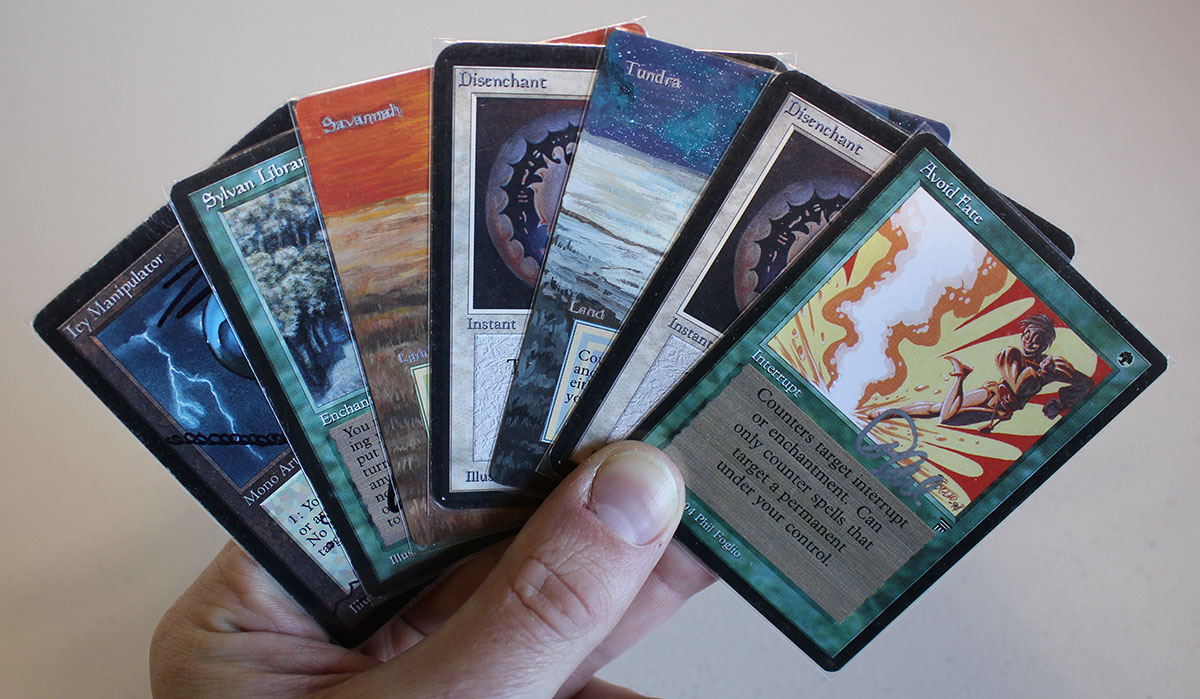
This hand is slow, but has mana, multiple Disenchants, and Sylvan. I’d keep this, and probably lean towards playing Tundra on the first turn (shielding Savannah from Strip Mine, because Sylvan Library is the most important card in hand), and then depending on what the opponent does (and what colors they are playing), you are going to either want to play Disenchant on the second turn, or Sylvan, or just pass. If you are able to find another green mana source before deploying Sylvan, it can be protected with your Avoid Fate, which may prove to be critical.
Opening Hand 2
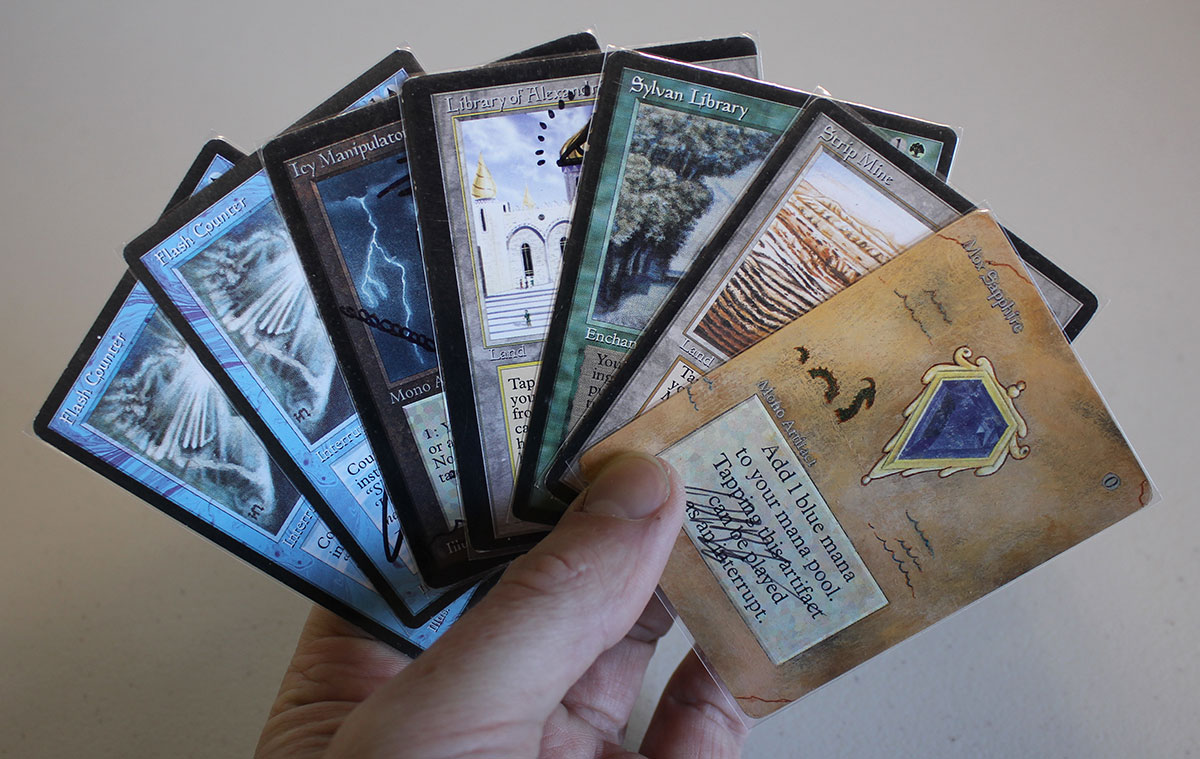
While we don’t yet have the mana to cast Sylvan or Icy, we do have both Strip Mine and Library of Alexandria. I’d keep this hand, and if I know my opponent is not likely to have Strip Mine, I’d lead with Library immediately. Otherwise, I’d lead with Strip Mine as bait for an opposing Strip Mine, and then play Library on the second turn most likely. If it sticks around for any period of time it will likely win you the game, especially if you can quickly find a green man to get Sylvan online.
Opening Hand 3
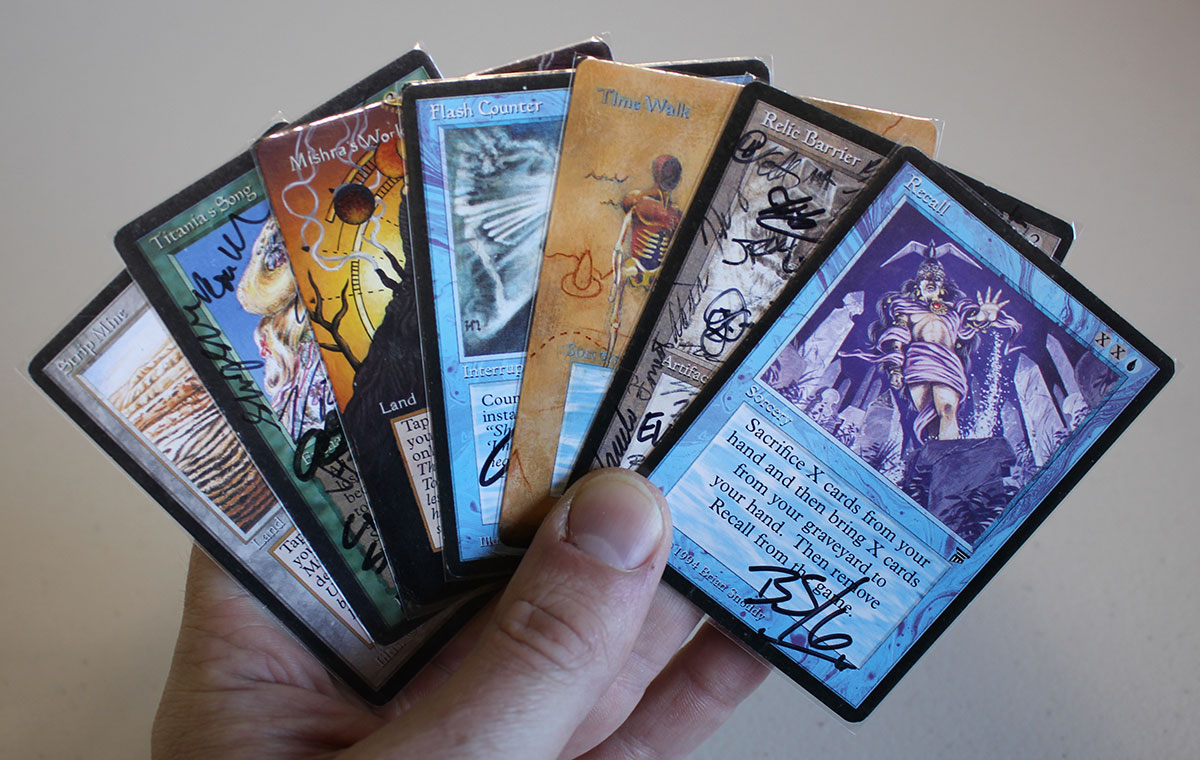
This hand of seven can cast a first turn Relic Barrier, and then not do much else without successive topdecks. It also contains Titania’s Song in it, which we don’t even want to see until the late game anyway, so this is functionally a six card hand already, so I’m going to throw it back for an actual six card hand that’s hopefully an improvement.
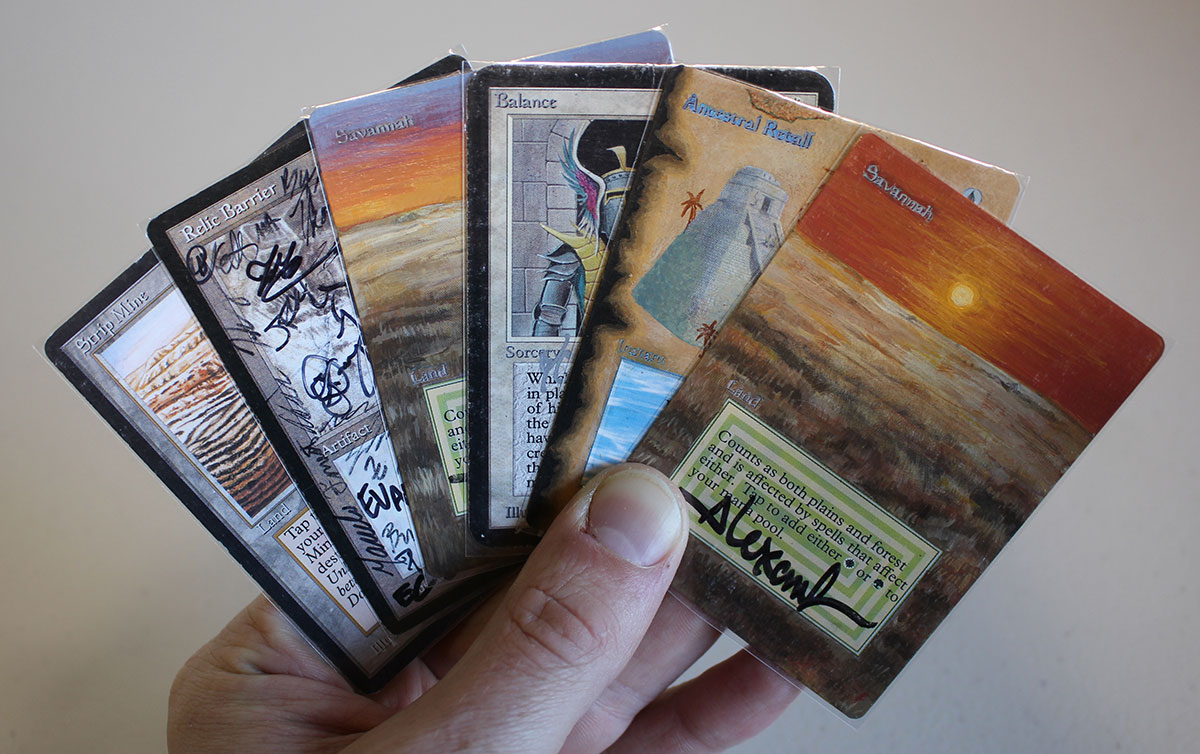
With mana, Strip Mine, Relic Barrier, and Balance, this hand has some modest forms of control for whatever we’re likely to see. If we can eventually find a blue mana source the Ancestral Recall is likely to pull us ahead, so I’m going to keep this one, and lead off with Savannah. With the pre-game scry I’m seeking either a blue mana source, Sylvan Library, or another artifact lock or control piece.
Opening Hand 4

The presence of removal, Icy, acceleration, and all of our colored mana requirements means this an easy (but unimpressive) keepable hand.
Opening Hand 5
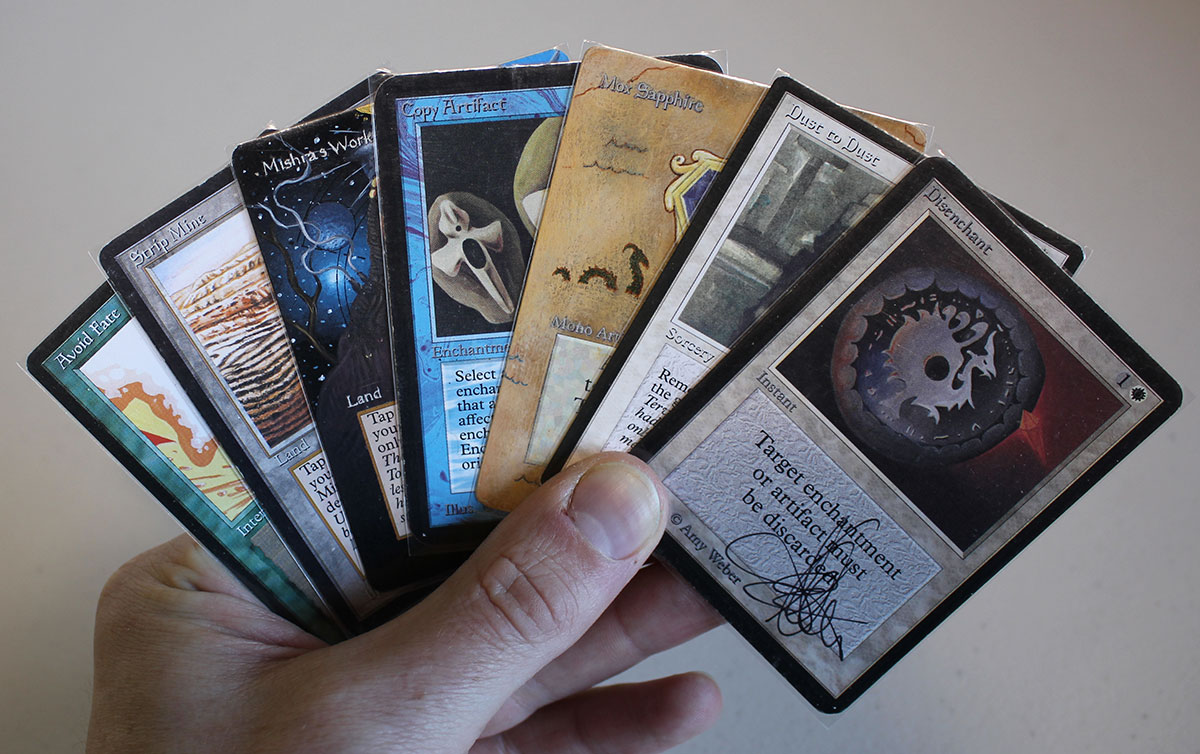
This hand does nothing other than Strip Mine the opponent, or possibly copy a relevant artifact if the cards fall right. No thank you; I will try my luck with the next six.
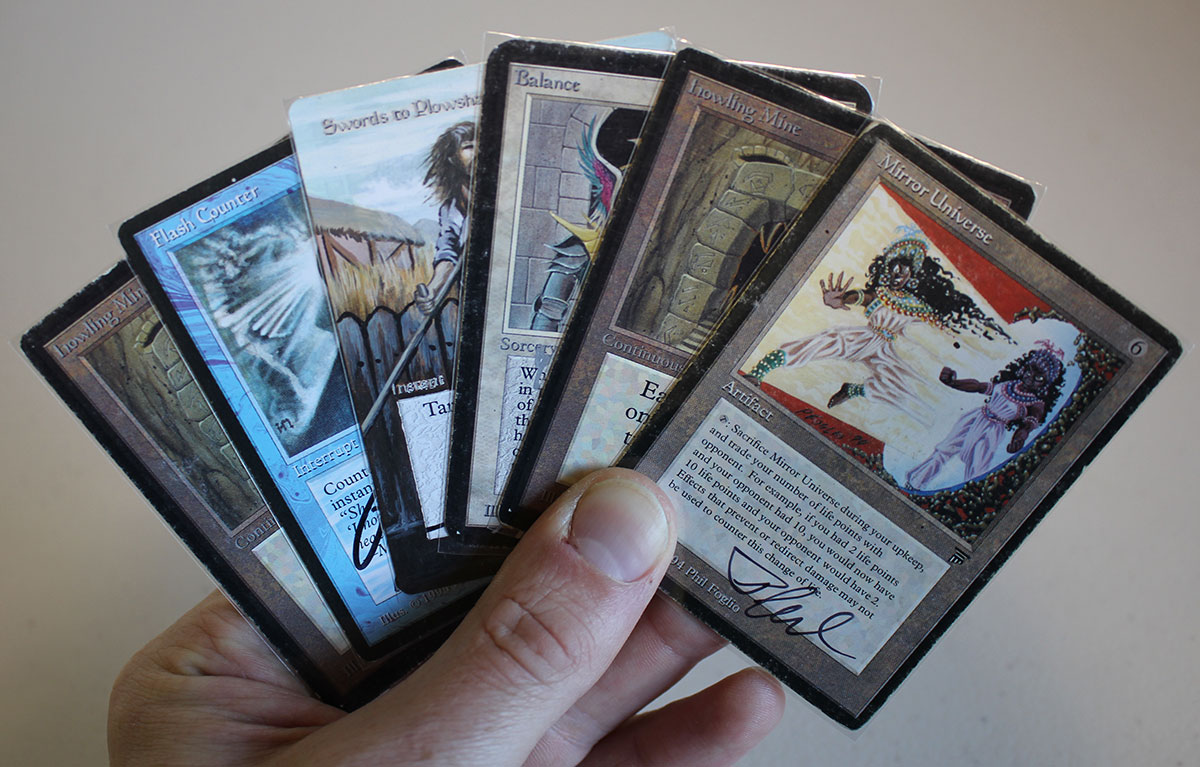
Mulliganing is not always kind, and this hand flat out sucks. I’m shipping it back for a fresh roll of the dice.
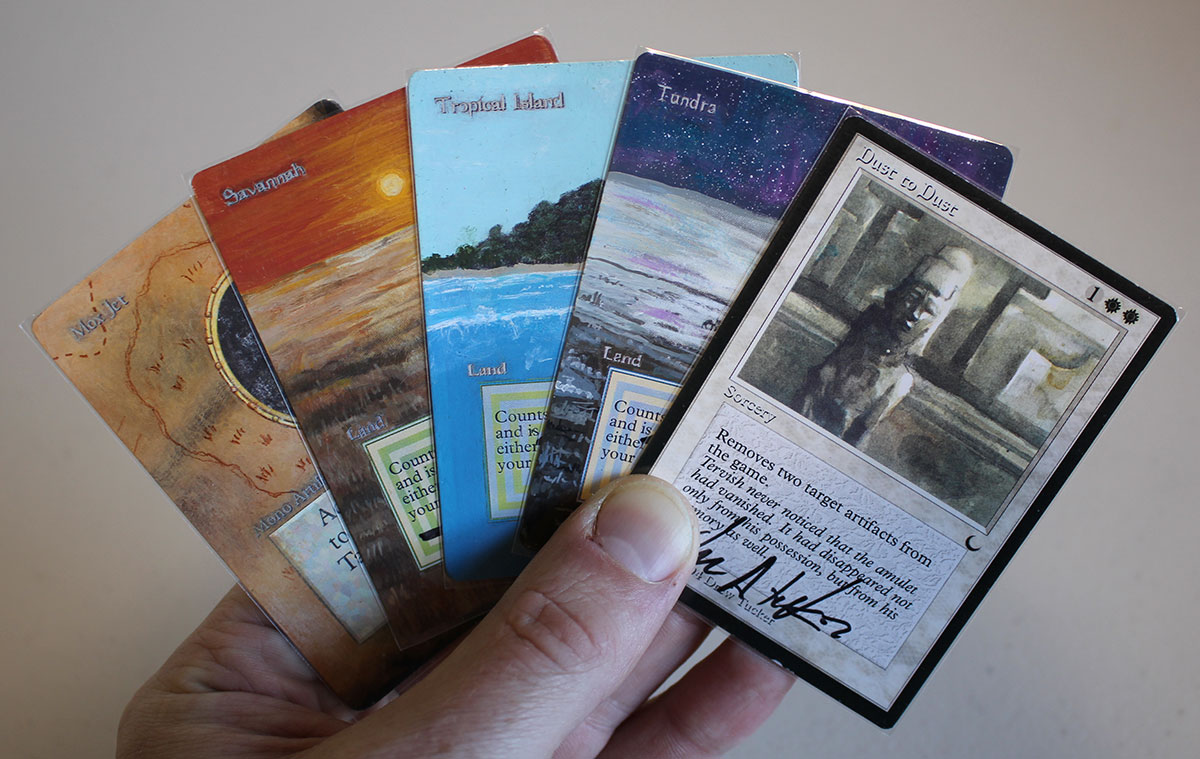
For a hand of five, this is actually pretty decent. We have all of the colored mana we could want in an opening hand, a piece of acceleration in Mox Jet, and a Dust to Dust should the opponent get some worrisome artifact like Juggernaut online quickly, or press their advantage in to playing a very early Jayemdae Tome or something. The Dust to Dust can actually help recoup one of our lost cards in the mulligans by two-for-oneing the opponent, which is fine. We are also well positioned to cast most of the cards we draw off the top.
Opening Hand 6
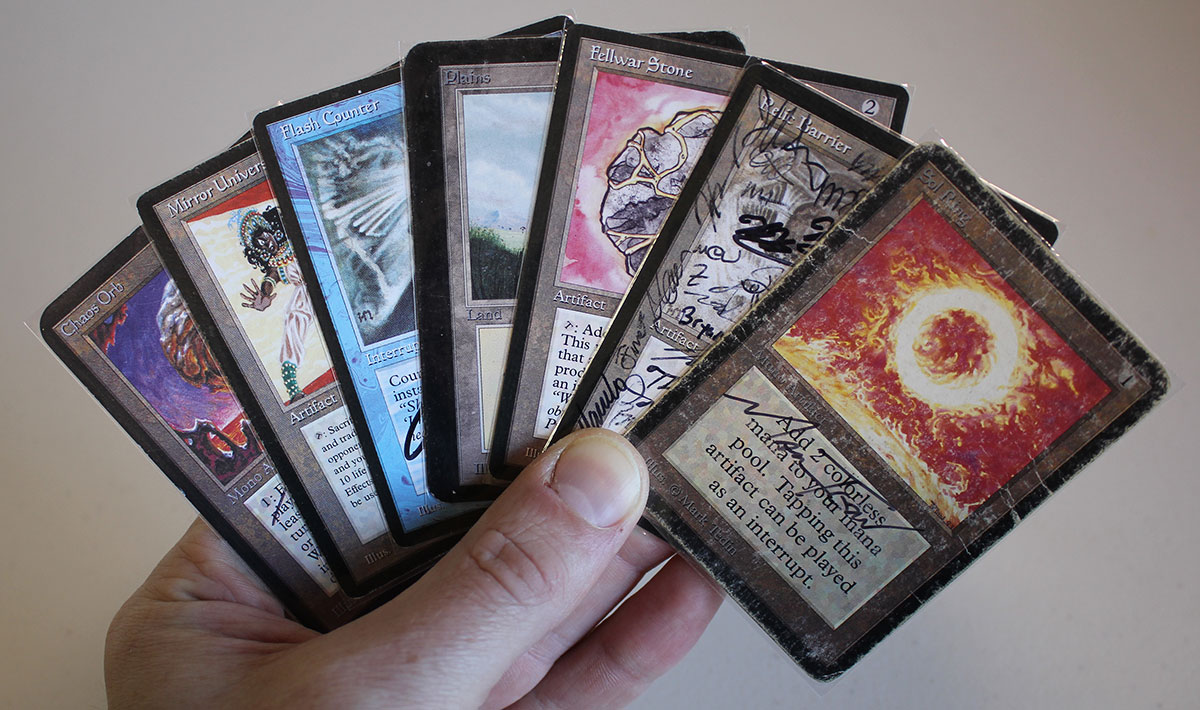
Our mana is decent, we have a couple control cards, and removal. Not great, but enough to keep it. I’d lead with Plains in to Sol Ring in to Fellwar Stone, and pass. I don’t like casting Chaos Orb unless I have the mana to immediately activate it, so I don’t recommend throwing it out naked early.
Opening Hand 7
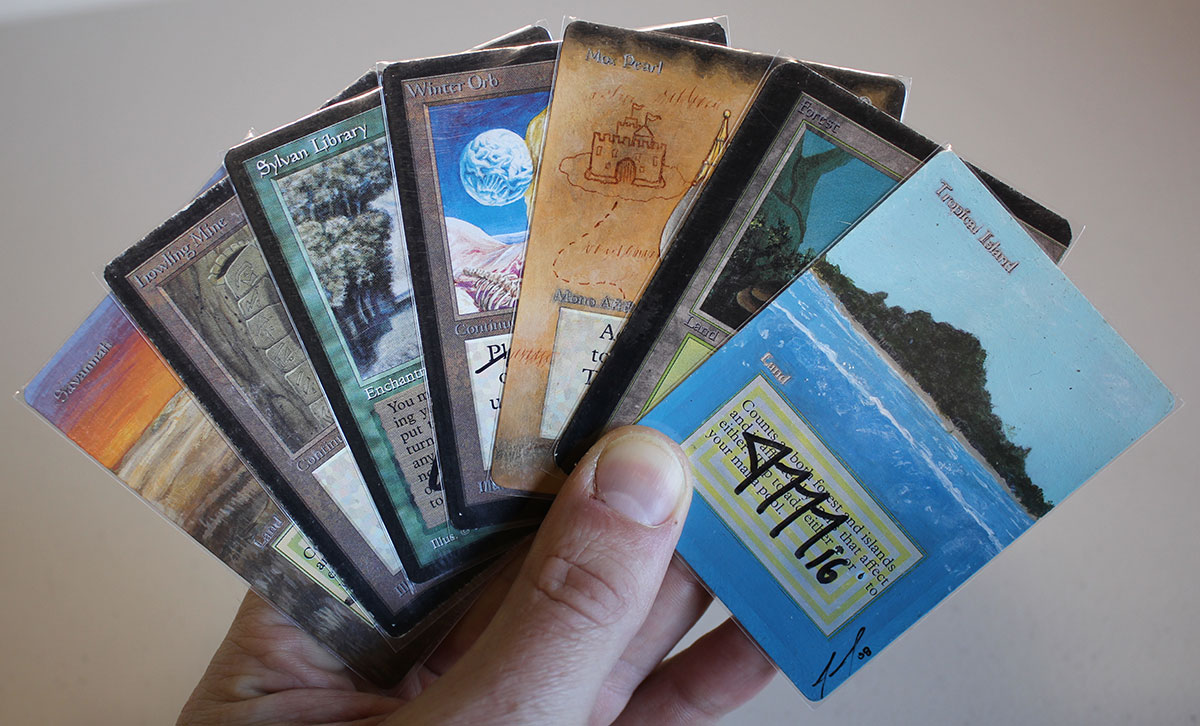
With mana and card draw and a prison element all on board, this is an easy keep. Depending on what you’re facing, and whether you’re on the play or draw, you’re either playing Howling Mine or Sylvan Library on the first turn. Against a very aggressive or burn-heavy deck, you want Sylvan. Against something where you want Sylvan in play ASAP (and potentially underneath Counterspell), you’d probably play Sylvan first, but against most other things leading with Howling Mine is probably better, in order to start drawing extra cards immediately, in order to find more mana and lock componentry.
Opening Hand 8
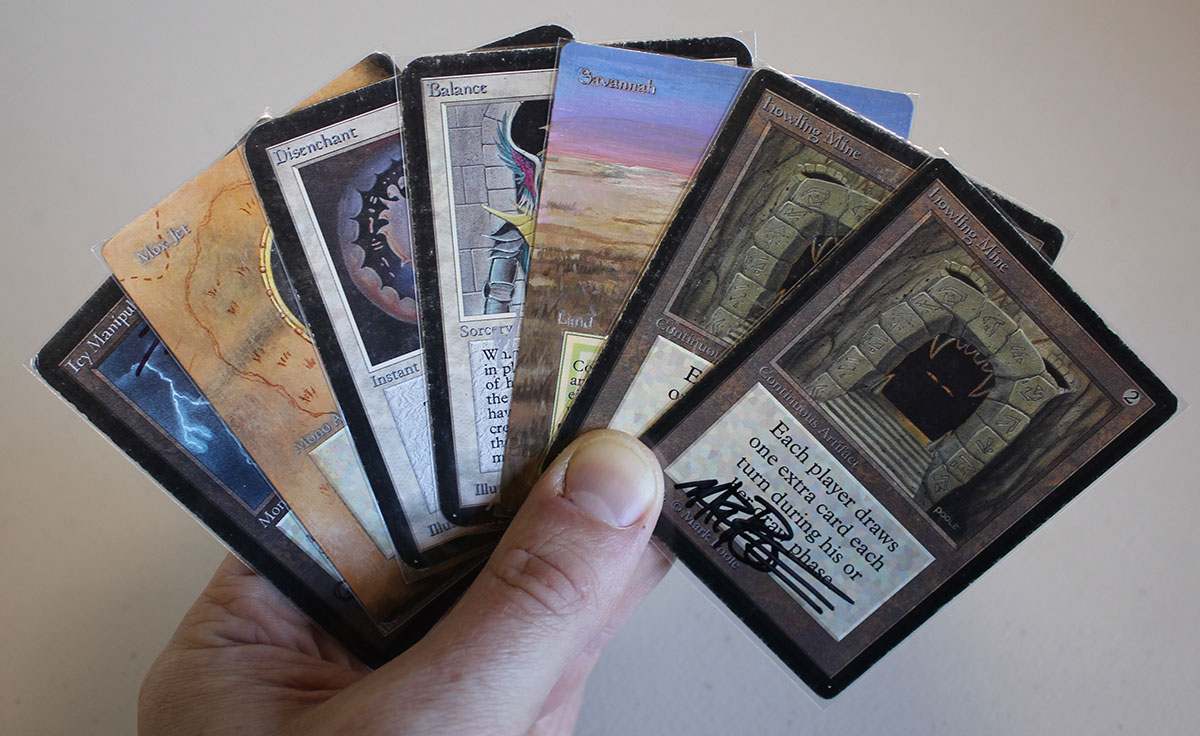
This hand looks pretty average, and that’s because it is, but it’s also keepable. With a first turn Howling Mine, with another lying in wait should that be dealt with, this has a way to find more mana easily, and has strong removal. If you find a Workshop soon to drop the Icy Manipulator, look out.
Opening Hand 9
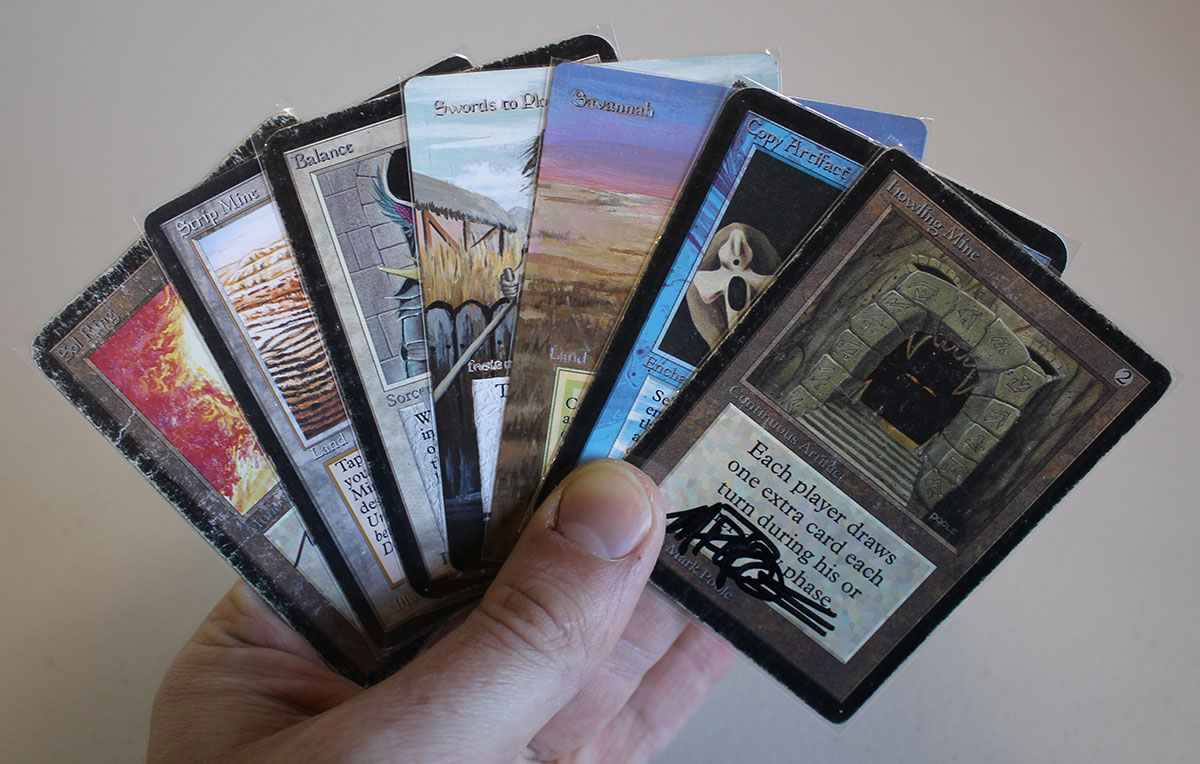
While this opener lacks the mana to cast Copy Artifact yet, we aren’t going to want to cast that until the mid-game anyway most likely. There is plenty of removal present, as is a first turn Howling Mine, so it’s a keeper. I’d likely lead with Strip Mine in to Sol Ring in to Howling Mine, in order to keep the Savannah in hand to be able to cast a white removal spell on time.
Opening Hand 10
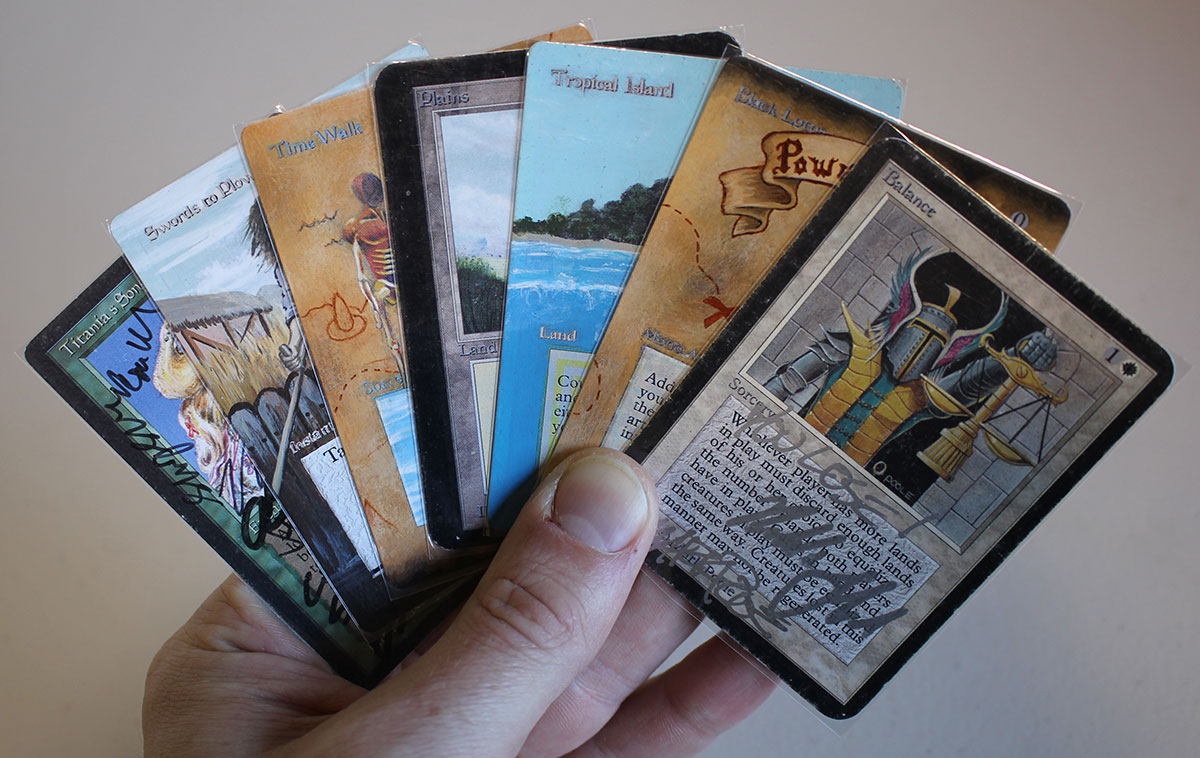
This hand is questionable, but probably a keeper. Titania’s Song sticks out as useless early, but we have removal, Time Walk, and enough colored mana. If the opponent leads off with a creature on the first turn this could be headed for a blowout, with something like Plains, Black Lotus, Time Walk, Balance. If they do nothing you can simply play Plains and pass, and slow walk the Time Walk and Lotus until you can really take advantage of them.
Concluding Thoughts
Titania’s Song is a unique kill condition that can be used in a number of color-splash variants. White is the best splash, due to all of the cheap removal it offers. Black and Blue splashes are a bonus for powerful cards like Ancestral Recall, Copy Artifact, Demonic Tutor, The Abyss, and more. If you are looking for a prison strategy in Old School (other than a Nether Void deck), this is a great place to begin experimenting.
Stay tuned to Eternal Central for more sick 93-94 brews all month long. Thanks for reading.

